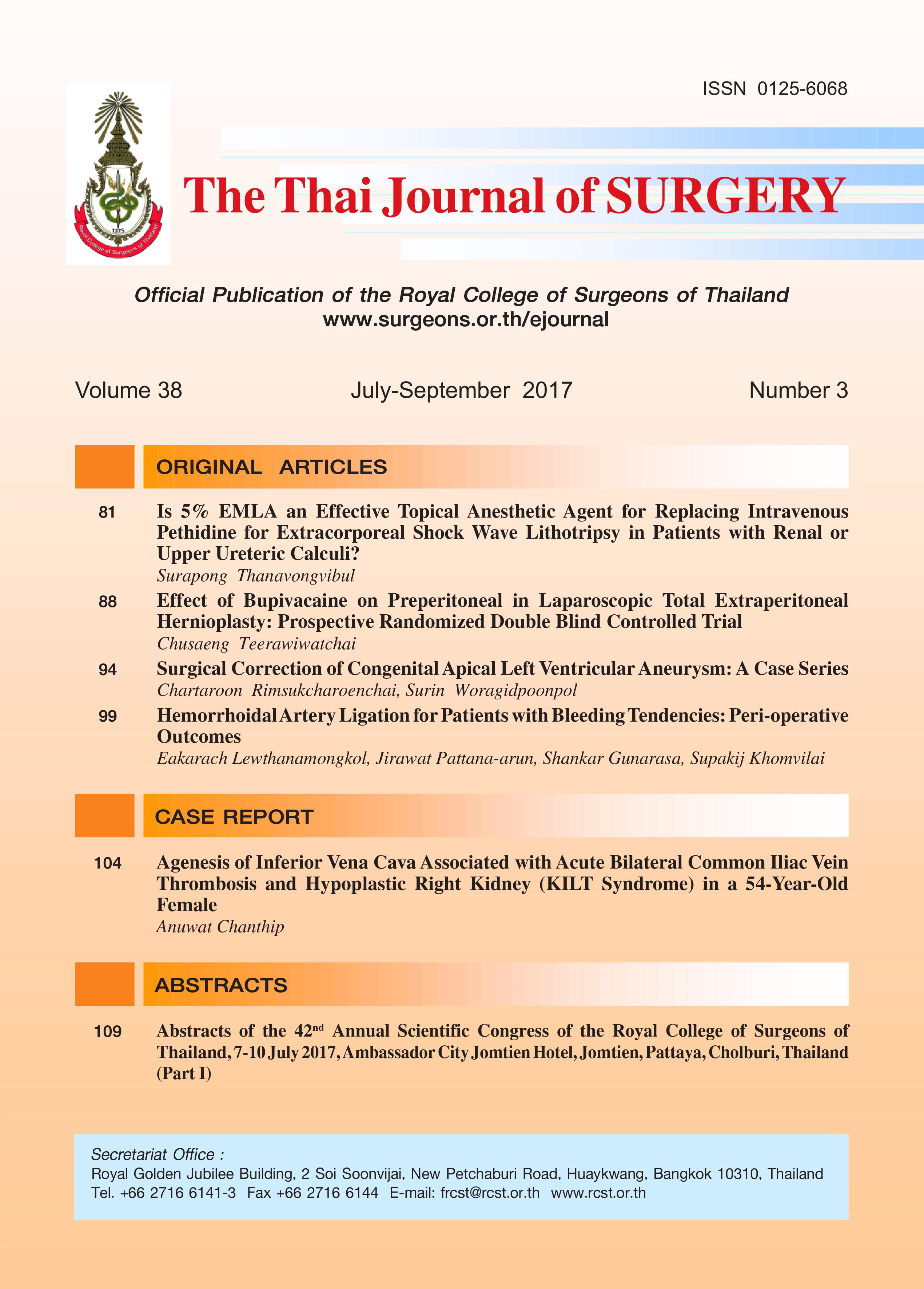Is 5% EMLA an Effective Topical Anesthetic Agent for Replacing Intravenous Pethidine for Extracorporeal Shock Wave Lithotripsy in Patients with Renal or Upper Ureteric Calculi?
Keywords:
ithotripsy, NRS, EMLA, pethidineAbstract
Background: Patients with renal or upper ureteric calculi may require extracorporeal shock wave lithotripsy (ESWL). To suppress the pain during the lithotripsy, commonly used medications included opioids, which give satisfactory analgesia but have numerous side effects.
Objective: This study was to determine whether 5% EMLA cream (a topical anesthetic agent) is an adequate analgesic for the lithotripsy, helping to reduce the use and side effects of opioid analgesics.
Materials and Methods: The study was a prospective, controlled, randomized, double-blind study. Patients were randomly assigned to either one of two groups (A, B) of 100 patients each. Groups A and B were treated with 5% EMLA and placebo cream, respectively.
Results: Both groups were comparable in terms of demographic data, gender, age, body mass index (BMI), site and size of the stones, American Society of Anesthesiologists physical status (ASA class) and comorbidities. The location or point of exposure of sound wave, duration and the number of lithotripsy shock waves were the same in both groups. Numerical rating scale (NRS) was used in the pain assessment. The pain score during the lithotripsy in the 5% EMLA group was found to be significantly lower than that in the control group. The amount of opioid (pethidine) used in the control group was significantly greater. The number of hospitalization hours following the lithotripsy in the control group was significantly higher. Significantly more patients in the control groups experienced dizziness, nausea and headache from intravenous (IV) opioids.
Conclusion: The 5% EMLA cream may be used to suppress the pain induced by the renal or upper ureteric lithotripsy and may help reduce opioid use, decreasing opioid-related side effects and hospitalization time.
References
2. Chcussy GC, Fuchs GJ. Current status and future development of noninvasive treatment of urinary stones with extracorporeal shock waves lithotripsy. J Urol 1989; 141Z3Pt 2:782-9.
3. Salinas AS, Lorenzo-Romoero J, Segrua M, et al. Factors determining analgesic and sedative drug requirement during extracorporeal shock wave lithotripsy. Urol Int 1999; 63:92-101.
4. Wever A, koehrmann KU, Denig N, Michel MS, Alken P. What are the parameters for predictive selection of patients requiring anesthesia for extracorporeal shock wave lithotripsy? Eur Urol 1998;34:85-92.
5. Gupta MP, Kumar A. Analgesia for pain control during extracorporeal shock wave lithotripsy: current status. Indian J Urol 2008;24:155-8.
6. Schelling G, Wever W, Mendl G, Braun H, Cullann H. Patient controlled analgesia for shock wave lithotripsy:the effect of self-administered alfentanil on pain intensity and drug requirement. J Urol 1996;155:43-7.
7. Geszitesi Z, Sa Rego M, Whith F. The comparative effectiveness of fentanyl and its newer analogs during extracorporeal shock wave lithotripsy under monitored anesthesia care. Anesth Analg 2000;90:567-70.
8. Parkin J, Keeley FX, Timoney AG. Analgesia for shock wave lithotripsy. J Urol 2002;167(4):1613-5.
9. Ganapathy S, Razoi H, Moote C, et al. Eutectic mixture of local anesthetics is not effective for extracorporeal shock wave lithotripsy. Can J Anesth 1996;43:1030-4.
10. Basaar H, Yilmaz E, Ozcan S, et al. Four analgesic techniques for shockwave lithotripsy: eutectic mixturelocal anesthetic is a good alternative. J Endourol 2003;17:3-6.
11. Barcena M, Radriguez J, Gude F, Vidal MI, Femandez S. EMLA cream for renal extracorporeal shock wave lithotripsy in ambulatory patients. Eur J Anaesthesiol 1996;13:373-6.
12. Yilmaz E, BatilamE, Basar MM, Tuglu D, Ozcan S, Basar H. Effectiveness of eutectic mixture of local anesthetic cream and occlusive dressing with low dosage of fentanyl for pain control during shockwave lithotripsy. J Endourol 2005;19:589-94.
13. Monk TG, Ding Y, Whithe PF, Albala DM, Clayman RV. Effect of topical eutectic mixture of local anesthetics on pain response and analgesic requirement during lithotripsy procedures. Anesth Analg 1994;79:506-11.
14. Ganapathy S, Razvi H, Moote C, et al. Eutectic mixture of local anaesthetics is not effective for extracorporeal shock wave lithotripsy. Can J Anaesth1996;43:1030-4.
Downloads
Published
How to Cite
Issue
Section
License
Articles must be contributed solely to The Thai Journal of Surgery and when published become the property of the Royal College of Surgeons of Thailand. The Royal College of Surgeons of Thailand reserves copyright on all published materials and such materials may not be reproduced in any form without the written permission.



